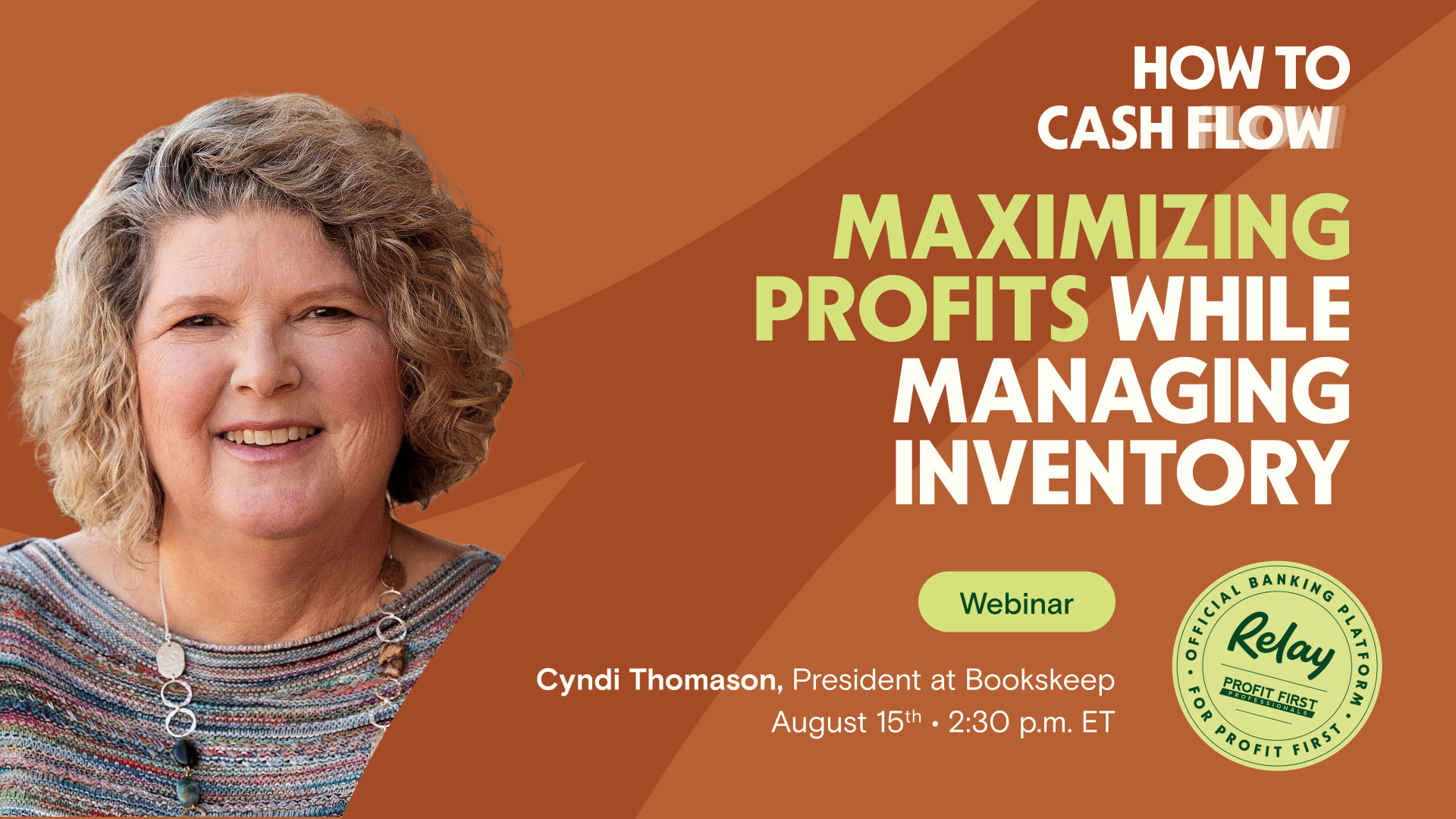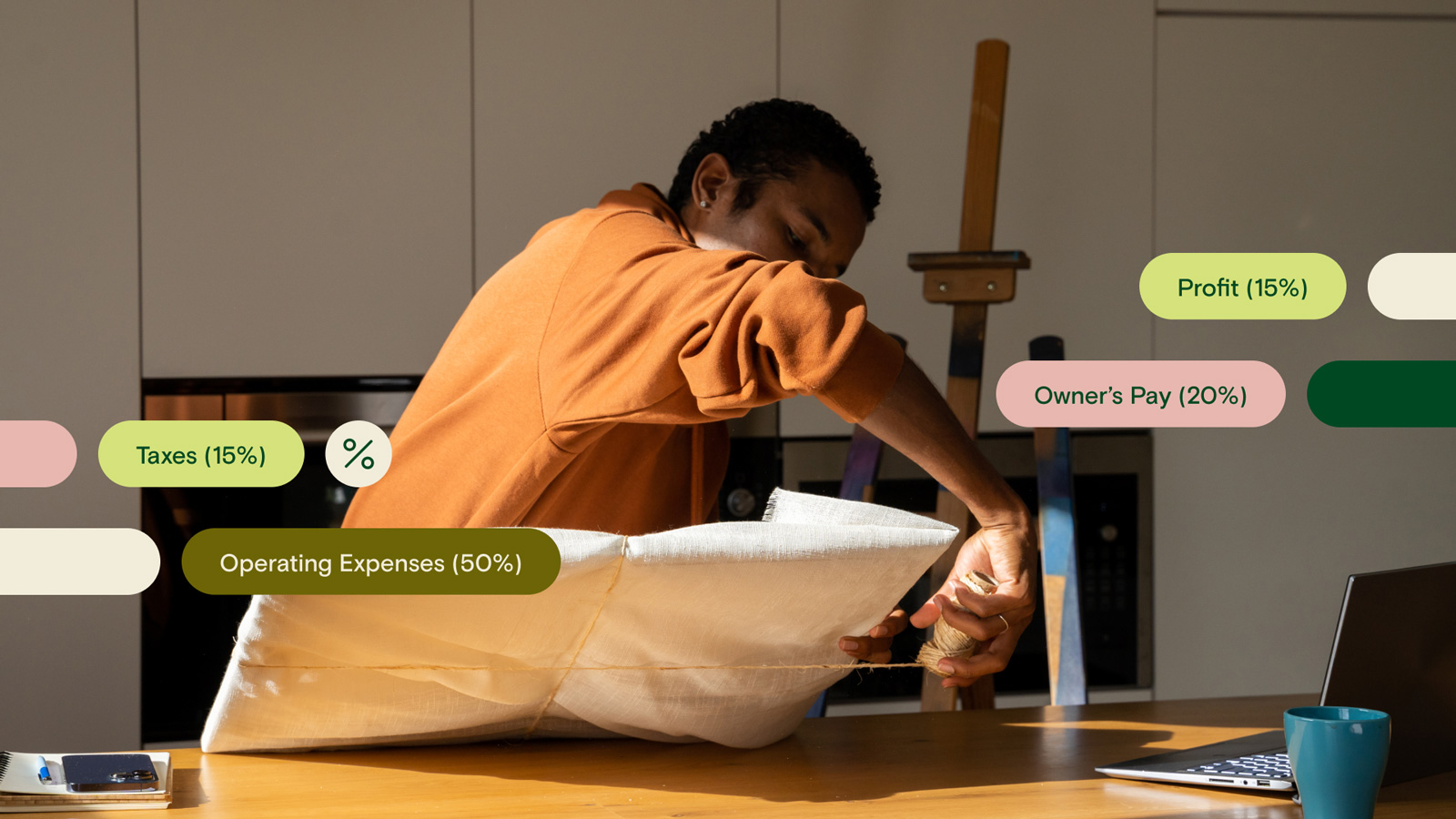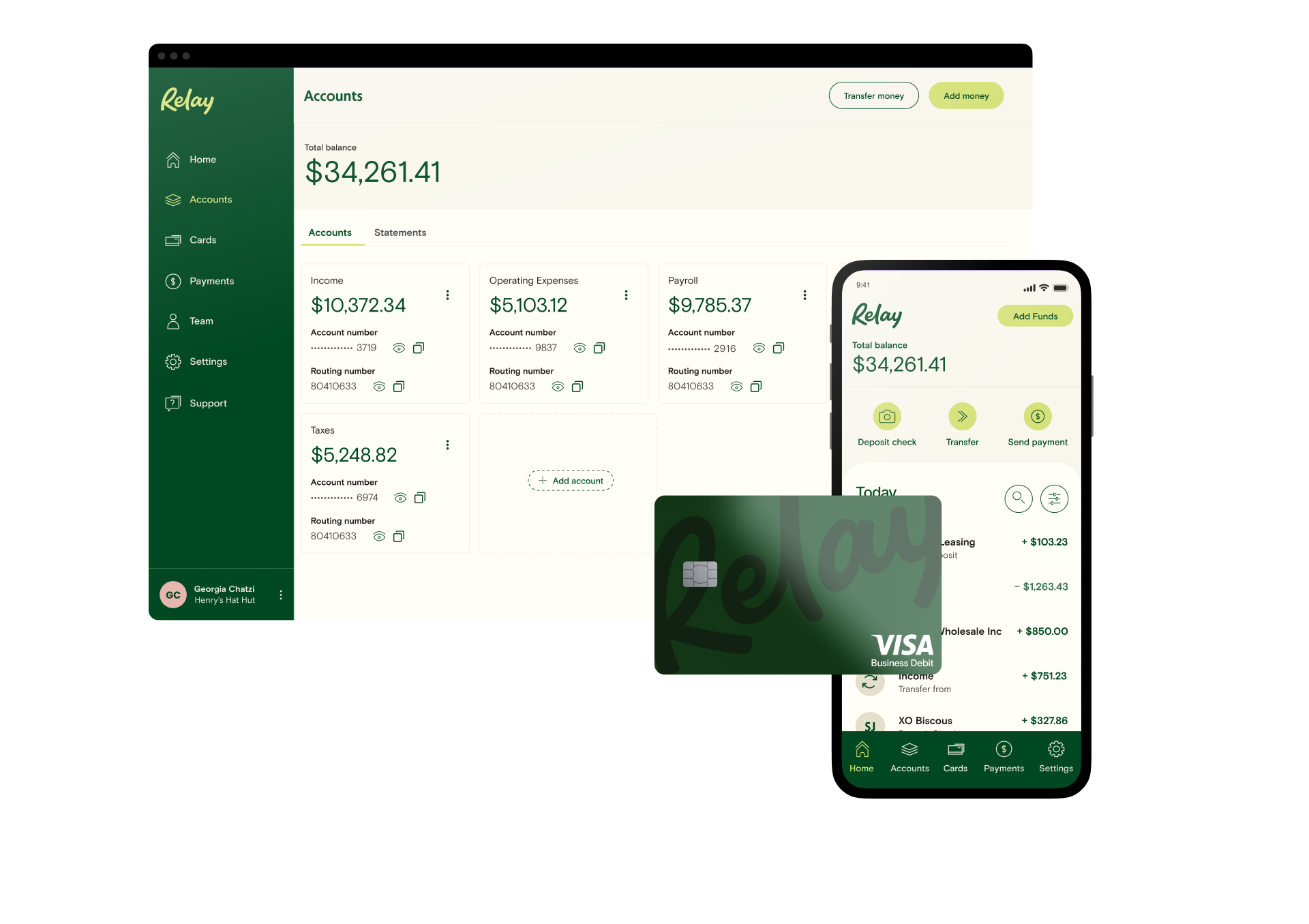The e-commerce industry can be uniquely challenging for small business owners. 🛍 If you feel like inventory costs are eating away at your hard-earned profit, you're not alone. We’re here to show you that there’s a better way to manage cash flow, and it starts by putting profit first. 💸
Profit First is a cash management method designed to ensure your business remains profitable by prioritizing profit over expenses. In this article, we'll cover exactly how to implement Profit First for e-commerce businesses:
What is Profit First?
Profit First is a cash management methodology developed by entrepreneur Mike Michalowicz. It's designed to help businesses prioritize profit over expenses, and it's based on the idea that your business should be profitable from day one.
To implement Profit First, small business owners allocate a percentage of revenue to profit first. This flips the traditional sales-expenses=profit formula on its head by changing it to sales-profit=expenses. Instead of allowing your expenses (or inventory) to determine your profit margin, you set aside a percentage of your income for profit before spending anything on expenses. 💰
After allocating profit, you would split up your remaining revenue across multiple checking accounts for different expenses. This allows you to quickly see how much money is budgeted for owner’s pay, taxes, and other business needs — instead of relying on mental math or complicated spreadsheets.
By putting profit first and managing cash flow with multiple checking accounts, business owners can transform their financial habits and become immediately and permanently profitable. 🙌💰
💡 For a deep dive into the Profit First method, check out our comprehensive guide here.
Who is the author of Profit First for E-commerce Sellers?
The Profit First method was originally introduced in a book by the same name, written by entrepreneur Mike Michalowicz. However, it was popularized among e-commerce sellers when Cyndi Thomason wrote the bestseller Profit First for E-Commerce Sellers: Transform Your E-commerce Business from a Cash-Eating Monster to a Money-Making Machine.
Cyndi Thomson is a certified Profit First Professional and the founder of bookskeep, a virtual company that provides bookkeeping services to e-commerce businesses.
Featuring a foreword by Mike Michalowicz, Cyndi's book addresses the challenges of running a cash-flow-positive e-commerce business. She provides strategies and tactics to help sellers maximize their profit margins while still investing in necessary inventory costs.
>>> Watch the on-demand webinar.

💻 Tune into Relay’s exclusive webinar with Cyndi Thomson and learn how to maximize e-commerce profits from the expert herself. During this live, recorded event, Cyndi illuminates the path to mastering inventory cash flow, controlling operating expenses, and transforming your business into a profitable venture. 💸 Click here to watch the webinar.
Why Profit First works for e-commerce sellers
When implemented properly, Profit First can help e-commerce sellers create a healthy profit margin and avoid cash flow emergencies.
E-commerce sellers have to face a wide range of challenges when it comes to managing inventory. It's not uncommon for items to go missing in the warehouse or during delivery. For instance, Amazon, despite its sophisticated logistics system, occasionally misplaces or loses inventory, causing significant headaches and financial losses for sellers. 😬
Another major struggle is predicting demand accurately, which is crucial for effective inventory management. Overestimating demand results in excess stock and wasted money, while underestimating demand can lead to lost sales and frustrated customers.
This can cause e-commerce sellers to become dependent on debt, constantly spending more money than they're making. By using the Profit First method, however, sellers can break this cycle and ensure their business is profitable from day one—regardless of sales volume or inventory issues. 🙌
Official banking platform for Profit First
Together, Profit First and Relay ensure that every dollar is allocated according to plan — be it paying down debt, reinvesting in your business, or taking a profit.
Learn MoreProfit First can also help e-commerce sellers in these areas:
💸 Better cash flow management: With Profit First, the funds allocated for inventory are clearly separated from other expenses. This system prevents the misuse of cash reserved for other business needs and improves cash flow management.
🔮 Increased financial visibility: By separating funds into dedicated expense accounts, e-commerce sellers can get a real-time view of their financial standing and make more informed decisions.
⚠️ Risk mitigation: By promoting disciplined spending and prioritizing profit, Profit First helps mitigate risks associated with overstocking or understocking. This method ensures that sellers have enough funds to handle unexpected inventory needs and can prevent stockouts or excess inventory.
How Profit First addresses inventory challenges
In Profit First for E-commerce Sellers, Cyndi encourages readers to open a separate business bank account for inventory. This gives sellers a clear picture of how much money they have for inventory—and helps them avoid spending money that should be dedicated to operating expenses, profit, or owner's pay.
Cyndo also tells e-commerce sellers to build up surplus funds in their inventory accounts, so they can use cash for last-minute inventory needs. This frees up your income for profit, instead of tying it up in credit card or loan payments. 💳
This is a unique approach to inventory: most e-commerce sellers spend as much money as they can on inventory and then hope for the best. Profit First helps e-commerce sellers create better habits by encouraging them to set aside a certain amount of cash before investing in inventory. That way, they can plan ahead and become more profitable in the long run. 📈
The 6 Profit First accounts for e-commerce sellers
To implement the Profit First method, business owners allocate a percentage of revenue for profit before any other spending. Then, in the basic Profit First model, they allocate the remaining revenue to operating expenses (OpEx), taxes, and owner's pay.
For e-commerce sellers, Profit First is a little different. In addition to the 5 common Profit First accounts (profit, income, OpEx, taxes, and owner’s pay), you'll need one more for inventory.
In Profit First for E-commerce Sellers, Cyndi explains the 6 Profit First accounts for e-commerce sellers and their differences:
Income: This account is for payouts from e-commerce platforms (like Amazon and Shopify), and will act as a "serving platter" — it will be emptied throughout the month as you make transfers to your other Profit First accounts (AKA, “dinner plates”).
Inventory: For e-commerce sellers, it's crucial to separate inventory from operating expenses. This is because inventory is something that you need to invest in before sales happen.
Operating Expenses: This account will hold any revenue dedicated to expenses like marketing software, business travel, and accounting fees — not inventory.
Profit: This should be a separate bank account dedicated to your business's profit.
Owner's pay: This account is for your personal salary as a business owner.
Taxes: Your taxes account will hold funds intentionally set aside for quarterly or annual tax bills.
Cyndi also discusses other, more advanced Profit First accounts in her book. However, she recommends that e-commerce sellers new to Profit First focus on these accounts first, and as their profit margins grow, implement additional strategies and accounts. 🏦
Profit First percentages for e-commerce sellers
Profit First recommends allocating a specific percentage of revenue to each of your accounts. Profit First suggests making your transfers on the 10th and 25th of each month, but ultimately, the exact dates will depend on your business's cash flow schedule. 📆
So how much money should e-commerce sellers transfer to each Profit First account?
In Profit First, Target Allocation Percentages (TAPs) specify the percentage of revenue that should be allocated to each account. The fundamental idea behind TAPs is to slowly adjust your business's cash flow habits — over time, the aim is to increase the percentages dedicated to profit and owner's pay while decreasing the percentage dedicated to operating expenses.
This gradual adjustment helps businesses to increase profitability, reduce wasteful expenses, and promote sustainable growth. The recommended TAPs depend on your business's real revenue:
A | B | C | D | E | F | |
Real Revenue Range | $0 - 250K | $250K - 500K | $500K - 1M | $1M - 5M | $5M - 10M | $10M - 50M |
(CAP) Real Revenue | 100% | 100% | 100% | 100% | 100% | 100% |
(TAP) Profit | 5% | 10% | 15% | 10% | 15% | 20% |
(TAP) Owner’s Pay | 50% | 35% | 20% | 10% | 5% | 0 |
(TAP) Tax | 15% | 15% | 15% | 15% | 15% | 15% |
(TAP) Operating Expenses | 30% | 40% | 50% | 65% | 65% | 65% |
It's crucial for e-commerce sellers to note that these percentages are based on real revenue—that is, revenue remaining after inventory is paid.💰 This is because inventory costs are a significant part of an e-commerce business's expenses and can drastically affect the profitability of the company.
By considering these costs, sellers get a more accurate picture of their actual profits, allowing them to make informed decisions and manage their funds more effectively. And remember: if even 5% feels like too much to allocate to profit right now, you can always start with 1%. The most important thing is to start making profit a habit. 👍
Banking Built for Business Owners
No account fees or minimums; 20 checking accounts; 2 savings accounts with 1.00%-3.00% APY; 50 virtual + physical debit cards. Open account 100% online.
Learn moreWhat is the best bank for Profit First for e-commerce sellers?
Whether you sell on Amazon or have your own online store, Profit First can transform your profit margins and grow your business. So how do you choose the right business banking platform for implementing Profit First?
Well, it’s crucial to find a business banking solution that will allow you to conveniently open multiple checking accounts. If you can do it for free, that’s even better. 🙌
That’s why so many e-commerce sellers love using Relay for Profit First banking: we make it easy to open multiple, no-fee checking accounts completely online. In fact, even Cyndi, the author of Profit First for E-Commerce Sellers, uses Relay for Profit First:
“One of my favorite features is that account owners can quickly issue a virtual or physical debit card to stay on top of team spending, and setting up your additional Profit First bank accounts is quick and no trouble at all!”
Banking Built for Business Owners
No account fees or minimums; 20 checking accounts; 2 savings accounts with 1.00%-3.00% APY; 50 virtual + physical debit cards. Open account 100% online.
Learn moreRelay is also the official banking platform for Profit First—and we offer small business owners helpful features like:
✅ 20 free checking accounts: Relay doesn’t charge overdraft fees, maintenance fees, or require a minimum account balance.
✅ Earn 1% to 3% APY on your savings*: Open two savings accounts with Relay and watch your money grow. Plus, our auto-transfer rules help you consistently move excess cash out of operating accounts and into savings.
✅ Percentage-based transfers: Save time with our pre-built Profit First template, designed to help you implement your Profit First allocations in seconds. Plus, when you’re ready, you can automate your transfers.
✅ 50 physical or virtual debit cards: Relay’s debit cards give you total visibility into spending with ultra-rich transaction data. You can your cards to organize spending by category, team member, and beyond.
✅ Streamline bookkeeping with accounting integrations: No more tax season headaches. Relay’s integrations with QuickBooks Online and Xero help you waste less time deciphering transactions, and more time growing your business.
If you’re ready to give Profit First a try, sign up for a free Relay account today!





